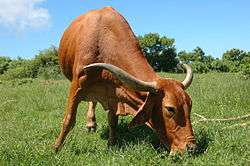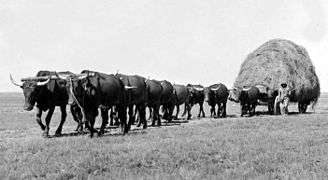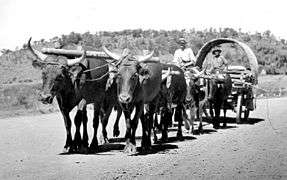Afrikaner cattle
The Afrikaner, also known as the Africander, is a breed of taurine-indicine ("Sanga")[1] cattle indigenous to South Africa.[2]
 Afrikaner cow grazing | |
| Other names | Africander |
|---|---|
| Country of origin | South Africa |
| Distribution | South Africa, Australia, Zimbabwe |
| Use | Beef |
| Traits | |
| Weight |
|
| Height |
|
| Coat | Red |
| Horn status | Horned |
| |
Huge herds of Sanga type cattle were herded by the Khoikhoi (Hottentots) when the Dutch established the Cape Colony in 1652. Although African cattle breeds originated from domesticized Auerochsen in the Middle East, there has been considerable introgression from wild African cattle (Bos Taurus Africanus) in North Africa, from the 8th millennium B. C. onwards, [3] Only two independent domestication events can be traced for the founding populations of cattle, the second being that of the Indian Zebu (Bos Indicus). However genetic studies indicate that African cattle breed are clearly distinct from European and Middle Eastern cattle by the crossbreeding with wild North African cattle (Bos Taurus Africanus), especially in the maternal line. At the same time African cattle have a great genetic variability. This indicates that crossbreeding with strains of wild African Auerochsen must have happened in different regions, with local strains. The aim was to introduce desirable traits such as environmental adaptation and resistance to disease and parasites. [4] This led to the development of specialised breeds of African cattle. Only much later, from 1500 B. C. on did crossbreeding with Zebuine cattle begin in Ethiopia and East Africa creating the ‘Sanga’ type. This was done mostly in the male line, with Indian bulls. This means that African cattle both of the more ‘taurine’ and the more ‘zebuine’ lineage share a rich heritage of wild African cattle, especially in the maternal lines, explaining their specific features and adaptations. For the Afrikaaner cattle this means that their specific character is not only to be explained by the Zebuine admixture, such as the marked hump. They are indigenous African heritage. This may be observed in the long lyra-shaped horns, which were already depicted on Ancient Egyptian murals. [5] They also characterise the White Fulani cattle of the Sahel, as well as the more Sanga types. (Elder photos of Afrikaaner cattle often show their horns to be somewhat more upright, than at present.) These breeds also share other features of stature and hardiness, fertility and endurance with the Afrikaaner cattle. For the understanding of Afrikaaner cattle and their special valuable traits, comparisons with other African breeds might thus be fruitful, to assess the genetic contribution of African wild cattle.
History
Afrikaners share coancestry with the Nguni and Drakensberger breeds. They most likely diverged 655–960 years ago.[6] Anecdotal evidence from Portuguese sailors suggest that herds of Afrikaner-like cattle had been kept by the Khoikhoi since at least the 15th Century.[2]
The breed almost became extinct in the early 20th century during the Second Boer War, their numbers depleted through destruction and due to an outbreak of Rinderpest[2] that halved the country's total cattle population.[7] After the war, programs were put in place to improve the breed.[8]
In 1912, the first Afrikaner studbook was formed in South Africa in order to control the breed's development. However, due to the recently depleted numbers of Afrikaner cattle, a high degree of inbreeding occurred at this time.[2]
In 1923, it was proposed that Afrikaners be sent to the United States,[9] and in 1932 the US government imported a herd to introduce new blood to the Gulf Coast.[10] In 1929, a bull and two cows (one a calf) were gifted to the King George V by the Africander Cattle Breeders' Society of South Africa.[11] The first five Afrikaners arrived in Australia in 1953 and were taken to the CSIRO's Belmont station for research into their adaptability to the Australian climate.[12] They were imported from Texas and Florida.[13]
During the first half of the 20th century, Afrikaners were being bred to reduce the size of their hump, as this was unsightly to farmers used to the taurine cattle shape.[14]
The Afrikaner was the most abundant cattle breed in South Africa until the 1970s, however, problems associated with inbreeding, lowered fertility and decreased reproductive period in cows decreased their popularity among local farmers. Crossbreeding with exotic cattle breeds may have also contributed to the decline in population numbers,[1] as well as the introduction of the Brahman to southern Africa.[15]
Breed characteristics
Afrikaners are usually deep red. The colour schema of the Afrikaaner with its shades of red to ochre, sometimes darker, is reminiscent of the lighter forms of Auerochsen, which have been prevalent in the races of southern Europe and North Africa. [16] While sexual dimorphism of colour was the rule, the lighter varieties had a more or less uniform brownish red, as the Afrikaaner cattle. D. Foidl explains: “This colour scheme is completely reddish brown with a dark eel stripe and dark forelocks, and having no black hair except for the tail tip. This colour scheme is similar to that of Banteng cows and found in wildtype-coloured domestic cows.” [17] [18] Some Afrikaner bulls have a fine light eel-stripe on the back, darker shaded shoulders and some locks on the forehead. They also have the small cervices-thoracic hump typical of Sanga cattle. The small hump of Sanga cattle is a trait essentially preserved from the Auerochsen. It is observable in the curvilinear back line of the Spanish Lidia, for example. It is distinguishable from the more lumpy hump of the Zebu cattle, and also differently placed. Only in some individuals a more Zebuine fat hump appears. A variety of traits appear to indicate that the Afrikaaner is a not too 'derived' breed that has preserved a variety of original traits, including some Zebuine influence.
The Afrikaner is a well-muscled breed, with long legs and a shallow body. They have long, lateral horns that turn upwards, although these are often polled in commercial operations. Bulls weigh 820–1,090 kg, and cows weigh 450–600 kg. The legs are slightly sickle shaped. They have good resistance to tick-borne diseases. They are well adapted to the local hot, arid conditions,[2] as the sweat glands in their skin are more active than those of taurine cattle. This makes them more tolerant of heat than European breeds.[19][20] They are more economical to keep, and a greater number of Afrikaners can be kept on the same plot of land as European cattle.[2] They have a good temperament and are easy to handle.[21]
Afrikaners have good fertility, and can continue to calve over the age of 16 years,[2] with records showing cows calving at 21.[11] The cows are very maternal, and one female will often care for a number of calves while their mothers graze elsewhere.[2] They have few calving problems, due to the structure of their hindquarters and small calf sizes (30–35 kg).[21] They have a low calf mortality rate.[2]
There is a medium to high degree of genetic variation within this breed with a low inbreeding coefficient, despite the historic decline in numbers.[1]
Uses
The Khoikhoi used the Afrikaners for meat and milk. Afrikaners were used primarily as draught animals after European settlement, often driven in large teams[22] with as many as 14 animals.[23] They were bred and developed to better suit this purpose, and were prized by the voortrekkers.[11] They were also used as dairy cows, though less commonly, producing higher butterfat contents than other cattle breeds, without the need for supplementary feed.[24] It was Afrikaner oxen which drew the wagons that carried the Voortrekkers on the Great Trek.
 An Afrikander Wagon Transport in the Orange Free State
An Afrikander Wagon Transport in the Orange Free State An Afrikander Wagon Transport in the Transvaal
An Afrikander Wagon Transport in the Transvaal.jpg) Pure Bred Afrikander Cattle at Ermelo, Transvaal
Pure Bred Afrikander Cattle at Ermelo, Transvaal
Commercial
Afrikaners are used commercially to produce beef, and are often crossbred with other breeds in order to improve meat quality, particularly in regards to tenderness, as well as their greater ability to add weight on poor quality forage. The South African breed society promotes the use of Afrikaners as a dam line for crossbreeding.[2]
Crossbreeding
Crossbreeding with Afrikaners increases the heat tolerance of taurine breeds.[19]
Bonsmara cattle are the result of crossing Afrikaners with Herefords and Shorthorns. They were developed during the 1960s.[6]
Belmont Red cattle are the result of crossing Afrikaners with Herefords and Shorthorns by the CSIRO in Rockhampton, Queensland. They were bred in an effort to produce a breed that was better suited to beef production in hot, dry areas.[25]
The Afrigus is a modern 50–50 hybrid of Afrikaner and Aberdeen Angus, with some influence of Bonsmara, Drakensberger and Tuli. An Afrikaner–Angus cross developed in the 1930s in Louisiana – sometimes called Africangus – was unsuccessful.[26]:101
References
- Pienaar, L; Grobler, J; Neser, F; Scholtz, M; Swart, H; Ehlers, K; Marx, M (2014). "Genetic diversity in selected stud and commercial herds of the Afrikaner cattle breed". South African Journal of Animal Science. Retrieved May 21, 2016.
- "History". The Afrikaner Cattle Breeders' Society of South Africa. Retrieved May 20, 2016.
- Pitt,Daniel, Natalia Sevane, Ezequiel L. Nicolazzi, David E. MacHugh, Stephen D. E. Park, Licia Colli, Rodrigo Martinez, Michael W. Bruford, Pablo Orozco‐ter Wengel, “Domestication of cattle: Two or three events?”, in: Evolutionary Applications – Special edition, 28th June, 2018 published by John Wiley & Sons Ltd. https://doi.org/10.1111/eva.12674
- Stock, Frauke & Diane Gifford-Gonzalez, Genetics and African Cattle Domestication, Afr Archaeol Rev (2013) 30:51–72, DOI 10.1007/s10437-013-9131-6
- Haager, Alexander P., „Die Domestikation des Altägyptischen Langhornrindes in Afrika“ - Eine Historische – Archäologische Evidenz, Vienna, 2011: Univ. of Vienna., pp. 177ff.
- Makina, Sithembile (2015). "Extent of Linkage Disequilibrium and Effective Population Size in Four South African Sanga Cattle Breeds". Frontiers in Genetics. 6: 337. doi:10.3389/fgene.2015.00337. PMC 4664654. PMID 26648975.
- "South African Cattle". Clarence and Richmond Examiner. May 28, 1901. Retrieved May 22, 2016 – via Trove.
- "The Rural Industries of South Africa". Advocate. November 24, 1906. Retrieved May 22, 2016 – via Trove.
- "Kelpies". The Land. July 10, 1923. Retrieved May 22, 2016 – via Trove.
- "Beef Cattle World and Meat Markets". The Farmer and Settler. January 2, 1932. Retrieved May 23, 2016 – via Trove.
- "Africander Cattle: A History of the Breed". Chronicle. July 11, 1929. Retrieved May 23, 2016 – via Trove.
- "Test Cattle for Belmont". Morning Bulletin. January 16, 1953. Retrieved May 23, 2016 – via Trove.
- "Stud Cattle For Tests". The Age. January 17, 1953. Retrieved May 23, 2016 – via Trove.
- B, R (October 4, 1941). "Africander Cattle Might Do Well in NT". The Australasian. Retrieved May 23, 2016 – via Trove.
- Beffa, L; van Wyk, J; Erasmus, G (2009). "Long-term selection experiment with Afrikaner cattle 1. Environmental factors affecting calf growth traits". South African Journal of Animal Science. doi:10.4314/sajas.v39i2.44384. Retrieved May 22, 2016.
- Foidl, Daniel, [colour scheme of wild Auerochsen] https://1.bp.blogspot.com/-RmO4ckDE1rM/Xndg3pca2xI/AAAAAAAAA6A/cDgnpqovKjk-2DsM7PKerDS_dUql10nKgCLcBGAsYHQ/s320/screen-capture-1%2BKopie.jpg
- Foidl, Daniel, "Aurochs cow colour schemes",in: The Breeding-back Blog, (22nd March, 2020). http://breedingback.blogspot.com/
- cf. Foidl, Daniel [illustration of Auerochs] in: Garrick, Dorian J and Anatoly Ruvinsky (eds.), The Genetics of Cattle, (2nd ed.), Boston, 2015: CAB Int., p. 624
- Vercoe, J; Frisch, J; Moran, J (1972). "Apparent digestibility, nitrogen utilization, water metabolism and heat tolerance of Brahman cross, Africander cross and Shorthorn x Hereford steers". The Journal of Agricultural Science. 79: 71–74. doi:10.1017/s0021859600025375.
- Vercoe, J (1970). "The fasting metabolism of Brahman, Africander and Hereford x Shorthorn cattle" (PDF). British Journal of Nutrition. 24 (3): 599–606. doi:10.1079/bjn19700061. PMID 5470766.
- "Why Invest with us". The Afrikaner Cattle Breeders' Society of South Africa. Retrieved May 20, 2016.
- Haggard, H (August 10, 1889). "King Solomon's Mines". Darling Downs Gazette. Retrieved May 22, 2016 – via Trove.
- "Two Warnings". Cobram Courier. March 9, 1893. Retrieved May 22, 2016 – via Trove.
- "Africander Dairy Cows". November 7, 1896. Retrieved May 22, 2016 – via Trove.
- "Rare calf born at S.A. school". Victor Harbour Times. June 16, 1977. Retrieved April 27, 2017.
- Valerie Porter, Lawrence Alderson, Stephen J.G. Hall, D. Phillip Sponenberg (2016). Mason's World Encyclopedia of Livestock Breeds and Breeding (sixth edition). Wallingford: CABI. ISBN 9781780647944.
- Felius, Marleen (1985) Genus Bos: Cattle Breeds of the World MSO-AGVET (Merck & Co., Inc.), Rahway, N.J., OCLC 13726656
- Mason, I.L. (1996) A World Dictionary of Livestock Breeds, Types and Varieties (4th ed.) C.A.B International, Wallingford, Oxofordshire, UK, ISBN 0-85199-102-5
- Timmins, Lisa (ed.) (1989) Handbook of Australian Livestock (3rd ed.) Australian Meat & Livestock Corporation, Sydney, ISBN 0-642-87194-9